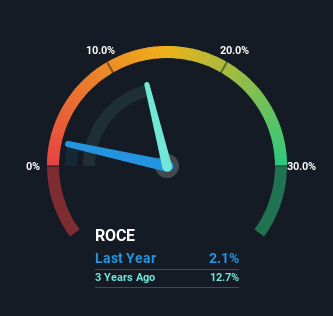- Hong Kong
- /
- Construction
- /
- SEHK:1183
MECOM Power and Construction (HKG:1183) Could Be Struggling To Allocate Capital

What financial metrics can indicate to us that a company is maturing or even in decline? When we see a declining return on capital employed (ROCE) in conjunction with a declining base of capital employed, that's often how a mature business shows signs of aging. This indicates the company is producing less profit from its investments and its total assets are decreasing. In light of that, from a first glance at MECOM Power and Construction (HKG:1183), we've spotted some signs that it could be struggling, so let's investigate.
What Is Return On Capital Employed (ROCE)?
For those who don't know, ROCE is a measure of a company's yearly pre-tax profit (its return), relative to the capital employed in the business. To calculate this metric for MECOM Power and Construction, this is the formula:
Return on Capital Employed = Earnings Before Interest and Tax (EBIT) ÷ (Total Assets - Current Liabilities)
0.021 = MO$11m ÷ (MO$1.1b - MO$576m) (Based on the trailing twelve months to December 2023).
Thus, MECOM Power and Construction has an ROCE of 2.1%. Ultimately, that's a low return and it under-performs the Construction industry average of 7.4%.
View our latest analysis for MECOM Power and Construction

Historical performance is a great place to start when researching a stock so above you can see the gauge for MECOM Power and Construction's ROCE against it's prior returns. If you want to delve into the historical earnings , check out these free graphs detailing revenue and cash flow performance of MECOM Power and Construction.
What Can We Tell From MECOM Power and Construction's ROCE Trend?
In terms of MECOM Power and Construction's historical ROCE movements, the trend doesn't inspire confidence. About five years ago, returns on capital were 16%, however they're now substantially lower than that as we saw above. And on the capital employed front, the business is utilizing roughly the same amount of capital as it was back then. Companies that exhibit these attributes tend to not be shrinking, but they can be mature and facing pressure on their margins from competition. If these trends continue, we wouldn't expect MECOM Power and Construction to turn into a multi-bagger.
While on the subject, we noticed that the ratio of current liabilities to total assets has risen to 53%, which has impacted the ROCE. Without this increase, it's likely that ROCE would be even lower than 2.1%. And with current liabilities at these levels, suppliers or short-term creditors are effectively funding a large part of the business, which can introduce some risks.
Our Take On MECOM Power and Construction's ROCE
In summary, it's unfortunate that MECOM Power and Construction is generating lower returns from the same amount of capital. Investors haven't taken kindly to these developments, since the stock has declined 51% from where it was five years ago. With underlying trends that aren't great in these areas, we'd consider looking elsewhere.
Since virtually every company faces some risks, it's worth knowing what they are, and we've spotted 2 warning signs for MECOM Power and Construction (of which 1 shouldn't be ignored!) that you should know about.
For those who like to invest in solid companies, check out this free list of companies with solid balance sheets and high returns on equity.
New: Manage All Your Stock Portfolios in One Place
We've created the ultimate portfolio companion for stock investors, and it's free.
• Connect an unlimited number of Portfolios and see your total in one currency
• Be alerted to new Warning Signs or Risks via email or mobile
• Track the Fair Value of your stocks
Have feedback on this article? Concerned about the content? Get in touch with us directly. Alternatively, email editorial-team (at) simplywallst.com.
This article by Simply Wall St is general in nature. We provide commentary based on historical data and analyst forecasts only using an unbiased methodology and our articles are not intended to be financial advice. It does not constitute a recommendation to buy or sell any stock, and does not take account of your objectives, or your financial situation. We aim to bring you long-term focused analysis driven by fundamental data. Note that our analysis may not factor in the latest price-sensitive company announcements or qualitative material. Simply Wall St has no position in any stocks mentioned.
About SEHK:1183
MECOM Power and Construction
Provides construction services in Macau, Hong Kong, Cyprus, and the People’s Republic of China.
Adequate balance sheet and fair value.
Market Insights
Community Narratives



